![]()
![]()
![]()
Use LEFT and RIGHT arrow keys to navigate between flashcards;
Use UP and DOWN arrow keys to flip the card;
H to show hint;
A reads text to speech;
57 Cards in this Set
- Front
- Back
|
What exactly are genetic mutations?
|
Changes in the nucleotide sequence of DNA that are passed on to the next generation
|
|
|
Mutations can be divided into two types. What are they?
|
1. Somatic mutations
2. Germ line mutations |
|
|
What is a somatic mutation?
|
They occur in body (somatic) cells only and they are passed on to daughter cells through mitosis
|
|
|
What is germ line mutation?
|
Mutations that occur in specialized cells (germ line) that give rise to gametes. This mutation is passed on at fertilization
|
|
|
Mutations have 4 different types of phenotypic effects? What are they?
|
1. Silent mutations
2. Loss of function mutations 3. Gain of funciton mutations 4. Conditional mutations |
|
|
What are silent mutations?
|
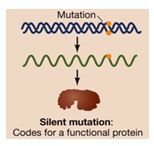
Mutations that DO NOT affect protein function. They can be found in either coding or non coding sequences
|
|
|
What is a loss of function mutation?
|
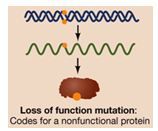
Mutations that DO affect proteins. They are almost always recessive
|
|
|
What is a gain of function mutation?
|
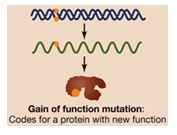
Mutations that lead to proteins with altered functions. They are usually dominant
|
|
|
What is a conditional mutation?
|
Mutations that cause their phenotypes only under CERTAIN restrictive conditions. For example: temperature
|
|
|
At the molecular level, we can divide mutations into two categories. What are they?
|
1. Point mutations
2. Chromosomal mutations |
|
|
All mutations are alterations in the ______ sequence of ______.
|
nucleotide, DNA
|
|
|
What is a point mutation?
|
Results from a GAIN, LOSS or SUBSTITUTION of a single nucleotide
|
|
|
What is a chromosomal mutation?
|
More extensive that point mutation. May change the position or cause a DNA segment to be lost or duplicated
|
|
|
Point mutations can result in errors in ______ OR to environmental ______
|
replication, mutagens
|
|
|
Point mutations usually result in the mRNA being altered, however silent mutations (by definition) have absolutely NO EFFECT on the resulting proteins. T or F?
|
True
|
|
|
There are four types of point mutations. What are they?
|
1. Silent
2. Missense 3. Nonsense 4. Frame-shift |
|
|
What are characteristics of silent mutations?
|
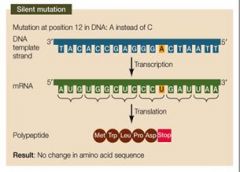
1. Have no effect on amino acids
2. Usually in non-coding regions 3. A substitution MAY be repaired in translation 4. Results in genetic diversity |
|
|
What are characteristics of missense mutations?
|
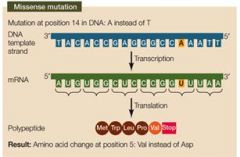
1. A substitution of one amino acid for another
2. May result in defective or reduced protein efficiency 3. A great example would be sickle-cell disease |
|
|
What are characteristics of nonsense mutations?
|
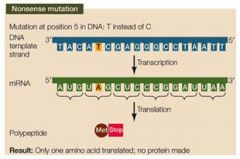
1. When a base substitution creates a STOP codon on the mRNA
2. A shortened chain is formed - which will most likely not be functional 3. If it occurs near the "natural" end of the mRNA, then it may be harmless |
|
|
What are characteristics of frame-shift mutations?
|
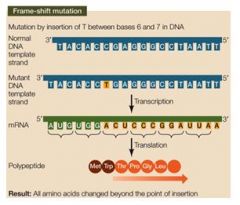
1. An ADDITIONAL base or a DELETION of a base on DNA.
2. This interferes with translation and the 3-codon reading is "shifted" 3. The protiens made in this fashion are non-functional |
|
|
There are 4 types of chromosomal mutations. What are they?
|
1. Deletions
2. Duplications 3. Inversions 4. Translocations |
|
|
What are characteristics of deletions in chromosomes?
|

1. Genetic material is removed
2. Severe consequences 3. No effect if noncoding DNA |
|
|
What are characteristics of duplications in chromosomes?
|

1. Homolgous chromosomes break in different places and re-attach to the wrong partner
2. Can happen at the same time as deletions |
|
|
What are characteristics of inversions in chromosomes?
|

1. When bases break off, but then flip before re-attaching
2. These bases end up in reverse order |
|
|
What are charateristics of translocations in chromosomes?
|

1. Bases break off one chromosome and re-attach to a completely different chromosome (a non-homozygous pair)
2. Often leads to duplications and deletions 3. May result in sterility because meiosis (the making of sex cells) is interrupted |
|
|
There are two CAUSES of mutations. What are they?
|
1. Spontaneous
2. Induced |
|
|
Spontaneous mutations occur with no ______ influence.
|
outside
|
|
|
Induced mutations occur due to ______ agent OR ______
|
outside, mutagen
|
|
|
Both spontaneous and induced mutations are not always permenant. T or F?
|
False: they are always permenant
|
|
|
Mutations have several benefits. What are they?
|
1. Provide genetic diversity
2. Can benefit the organism immediatley (in somatic cells) 3. Can cause advantageous change in offspring |
|
|
How do bacteria fight off viruses?
|
Through restriction enzymes. The virus shoot it's DNA into the bacteria and the restriction enzymes within the bacteria cleave it up into small fragements making it useless.
|
|
|
Where do restriction enzymes come from?
|
They are harvested from the cells that actually make them (i.e. the restriction enzyme EcoRI comes from the bacteria E.coli)
|
|
|
How does a bacteria keep its native restriction enzyme from cleaving up its OWN dna?
|
Methyl groups at restrictions sites BLOCK the restriction enzyme
|
|
|
What process do we use to separate DNA fragments that have been cut by restrictions enzymes?
|
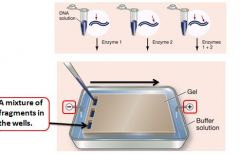
Gel electrophoresis
|
|
|
In gel electrophoresis, do shorter or longer DNA fragments travel faster and longer through the gel?
|
Shorter fragements
|
|
|
When a mutation is expressed phenotypically (because of proteins that differ from the "norm"), we usually call this a ______.
|
Disease
|
|
|
An example of a disease that results from an abnormal enzyme phenylalanine hydroxylase is called what?
|
PKU (Phenylketouria Disease)
|
|
|
Explain the disease PKU.
|
1. In normal people, phenylalanine hydroxylase catalyzes dietary phenylalanine into tyrosine
2. PKU patients have an abnormal version of this enzyme and therefore DO NOT catalyze tyrosin. As a result, dietary phenylalanine builds up in their bodies. 3. Causes retardation, light skin, light hair color |
|
|
Explain sickle-cell anemia
|
1. Patiens have an abnormal allele that creates an abnormal hemoglobin which is sickle shaped
2. These cells block blood flow and causes anemia |
|
|
What is reverse genetics?
|
1. Normally, a protein phenotype is discovered first, then the gene which produced the protein
2. In reverse genetics, the abnormal gene is located FIRST, and THEN the protein it created is characterized |
|
|
What is an example disease that was discovered using reverse genetics?
|
Cyctic fibrosis (sickle cell anemia was discovered using the standard way)
|
|
|
In reverse genetics, in order to identify the mutant gene, close linkage to a ______ sequence is used
|
marker
|
|
|
What is a genetic marker?
|
A reference point for gene isolation
|
|
|
In order to design therapy treatments, it is important to identify the ______ involved in a disease.
|
protien
|
|
|
What does RFLP stand for?
|
Restriction fragement length polymorphisms
|
|
|
What are RFLP's?
|
They are differences in DNA sequences (due to mutations) that PREVENT restrictions enzymes from chopping up the DNA.
For example, a specific restriction enzyme can cut up GAATTC. But the mutated version GAGTTC can NOT be cut up. |
|
|
What is SNP?
|
Single-nucleotide polymorphism
For example, take the following strings: AAGCCTA and AAGCTTA They differ by just one single nucleotide. This is an SNP |
|
|
Now that the human genome has been fully sequenced, what does this provide us with?
|
An easier way to identify markers that are more closely linked to the gene of interest.
|
|
|
Once a linked DNA region is identified, many methods are available to identify the actual gene responsible for a genetic ______.
|
disease
|
|
|
Being able to isolate genes that are responsible for diseases has led to what?
|
1. Tests for mutations
2. Protein identification 3. Possible treatements |
|
|
What is genetic screening?
|
Use of a test to determine if an induvidual has a genetic disease, or if predisposed to one or is a carrier
|
|
|
What are several example of genetic screening?
|
1. Pre-natal screening
2. Screening of newborns 3. Screening asymptomatic people with relatives who have genetic diseases |
|
|
There are two main approaches to treating genetic diseases. What are they?
|
1. Modifying the disease phenotype
2. Replacing the defective gene |
|
|
Modifiying a disease phenotype can be accomplished in 3 ways. What are they?
|
1. Restricting the substrate - reducing it so it does not cause problems
2. Metabolic inhibitors - drugs that target proteins 3. Supply the missing protien - for example, a supplement |
|
|
How do we replace the defective gene through gene therapy?
|
The missing allele can be supplied by inserting a new gene that will eventually be expressed in the host
|
|
|
What are some challenges with gene therapy?
|
1. Ensuring precise insertion into the host DNA
2. Ensuring appropriate expression 3. Ensuring the correct cells are targeted |
|
|
Break down of ALL mutation types, effects, categories and causes.
|
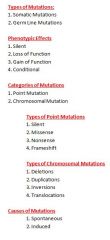
See illustration
|

